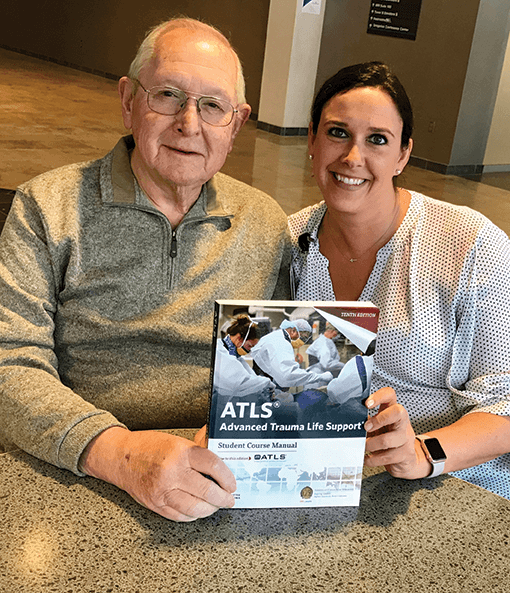Dr. Collicott, Past-Director of the ACS Division of Member Services and a recipient of the College’s Distinguished Service Award, arrived in Lincoln in 1973 after completing his general surgery training at the University of Washington, Seattle. Prior to surgical training, Dr. Collicott spent two years in the U.S. Air Force during the Vietnam War, and was anxious to begin his surgical career in the American heartland. By 1978, Dr. Collicott was already a recognized member of the ACS COT, and he introduced the concept of the ATLS program at the 1979 ACS COT annual meeting in Houston, TX. The COT enthusiastically endorsed the proposal and called upon its Region Chiefs to meet in Lincoln for an introduction to the course.
The original funding for the course was provided by an EMS state grant, and when the ACS took over, all materials were handed over with no contract or financial agreement, according to Dr. Collicott.
The following January 1980, the ACS COT Region Chiefs were called to meet in Lincoln for their introduction to the course. At this meeting, Norman McSwain, MD, FACS, a surgeon from Louisiana, became involved in the rollout of the ATLS program. Although not a Region Chief, Dr. McSwain was invited because of his influence and knowledge of EMS. Later that year, ATLS was presented in eight additional cities: Denver, CO; San Diego, CA; Philadelphia, PA; Milwaukee, WI; Dallas, TX; Washington, DC; Newark, NJ; and Auburn, AL.
Where are they now?
When this journey started, my goal was to locate Dr. Styner. I had heard he was living in California and did my best to locate him, but instead, I was able to connect with his son, Randy. Randy and I began communicating via e-mail and quickly became friends, sharing family pictures and so on. Randy works in emergency management in California and has served his country as a U.S. Marine. Dr. Styner is living in the Philippines with his wife, Lily. I was able to communicate briefly with Lily via Facebook; however, I have not been able to communicate with Dr. Styner. Unfortunately, Dr. Styner is ill and was unable to speak to me. Randy and his siblings went to the Philippines in 2017 to visit their father, and at that point, Randy informed Dr. Styner about my research regarding the history of the course, and he even got Dr. Styner to sign Randy’s book The Light of the Moon: Life, Death and the Birth of Advanced Trauma Life Support; this was the best gift I could’ve received.
Dr. Craig and his wife remain in Lincoln in the same house in which the initial ATLS outline was written. In fact, the first time I visited Dr. Craig, he had set up an old projector and had the original ATLS slideshow for me to view. He continues to volunteer at LMEP, twice a week. Randy returned to Lincoln in September 2017 to speak at our annual trauma symposium, reconnect with old family friends, see our trauma center, and visit his mother’s final resting place. Randy, Dr. Craig, and I participated in an Eastern Association for the Surgery of Trauma Traumacast (a webcast) this past year about the birth of ATLS.
As for updates on the ATLS original faculty: Dr. Reed and Dr. Lau remain in the Lincoln community. Both are retired; however, Dr. Reed continues to work six days a week seeing wound patients. Dr. Mota and Dr. Gogela are both deceased; however, Dr. Gogela’s grandson is very active as a neurosurgeon at Bryan Trauma Center. Dr. Mota’s sons are both physicians; one is a general surgeon who also takes trauma calls at Bryan Trauma Center, and the other is an ophthalmologist. Dr. Fruehling is a primary care physician who still practices in Grand Island, NE. And, finally, Dr. Collicott enjoys the retired life with his wife Irvene Collicott, formerly Hughes, splitting his time between Lincoln and his home in Wyoming.
Bryan Memorial Hospital and Lincoln General Hospital merged in 1997 and became Bryan Medical Center. Bryan Medical Center is a 640-bed, not-for-profit, locally owned health care organization serving patients from throughout Nebraska, as well as parts of Kansas, Iowa, South Dakota, and other states in the region. The Bryan Trauma Center is an ACS Level II verified adult trauma center and was the first verified trauma center in the state of Nebraska.
The ultimate goal of each of these individuals and the medical center where ATLS launched was to improve care of the injured patient. That goal didn’t initially include the creation of a course that would become the gold standard of trauma care and save millions of lives around the world, but that is precisely what happened.
Now, as we prepare to celebrate the 40th anniversary of ATLS and the release of the 10th Edition, we are seeing the same multidisciplinary approach to saving lives with the Stop the Bleed® campaign—an initiative that also was inspired by a tragic event, in this case the December 2012 fatal shooting of 20 children and six teachers at Sandy Hook Elementary School in Newtown, CT, which led a handful of individuals to make a substantial change in how victims of mass casualty events are treated.





